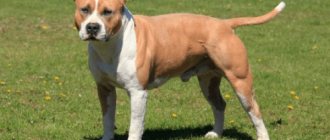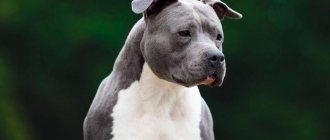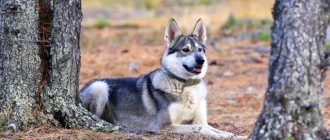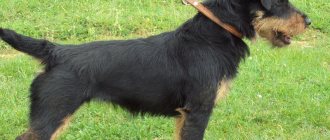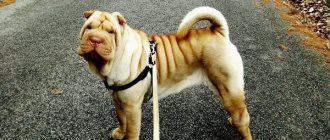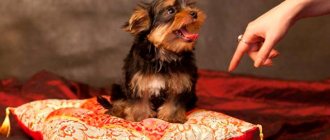The American Staffordshire Terrier is a strong, hardy dog with a cool disposition, and therefore training a Staffordshire Terrier has its own characteristics. The Staffordshire Terrier is highly intelligent, naturally intelligent and highly trainable. But any experienced dog trainer will confirm that the nuances of the psyche and character of Staffords impose some obligations on their owners when it comes to raising and training a dog. Today we will tell you how to structure the process of training a Staffordshire Terrier in such a way as to not only achieve the desired result and get a smart, obedient and controllable pet, but also to really learn to understand the dog and manage it so that the animal trusts the owner and obeys him unquestioningly.
Stafford training: features
Features of the psyche and character of the Staffordshire Terrier
Of course, a dog’s behavior is a reflection of its upbringing, and this dogma applies to any animal. But each representative of a particular breed has certain mental and character traits at the genetic level, and below we will talk about the breed traits of Staffordshires.
Many Stafford owners note that these are dogs whose mood changes at lightning speed. Representatives of this breed can switch from a playful mood to a wary mood in one second, and from rest and even deep sleep to a readiness to act. These are definitely choleric people, and this psychological feature of Staffies needs to be taken into account both before getting a puppy and when starting to raise and train the dog.
Staffordshires have an excitable psyche
Despite the fact that people who are less familiar with the breed believe that Staffordshires are uncontrollable and unbalanced dogs, this is not so. Do not confuse activity and sensitivity of character with nervousness or even aggression. Stafford, whose upbringing was given enough attention, is a dog with stable and predictable behavior, while it is not easy to unbalance the animal, for this you need to cause him physical pain.
Since Staffordshire Terriers were bred to fight other dogs, they have virtually no aggression or anger towards humans. Staffies get along well with children, are extremely devoted to their owner and are ready to do anything so as not to upset the owner. Therefore, training Staffordshires is quite easy, provided that the process is enjoyable for both man and dog.
Despite their menacing appearance, Straffords are gentle dogs.
Table 1. Mental traits characteristic of straff
| Trait | Description |
| Loyalty to man | The dog, without hesitation for a second, will protect the owner and members of his family, including at the risk of his own health and even life |
| Patience, endurance | Staffs are able to endure not only pain, but also not to succumb to provocations from children and other animals. Sometimes representatives of this breed are accompanied by the epithet “reinforced concrete”, precisely for their calmness |
| Fearlessness | Staffordshires have no fear of danger - representatives of this breed do not retreat even if the enemy significantly outnumbers them or is stronger |
| Security qualities | Staffordshires are excellent bodyguards and also vigilant watchmen. These dogs can be trusted with both property and territory protection. |
| Restraint | The staff will not whine or bark without a reason, and if there is sufficient stress in the dog’s life (both physical and mental), during the rest period the animal is not visible or heard |
| Activity, energy | Staffordshires love movement and will take part in all the activities of their family. These dogs adapt perfectly to any conditions and feel comfortable anywhere, as long as the owner is nearby. |
| Tendency to be dominant towards other dogs | Leadership in a pack is inherent in Staffordshires, and representatives of this breed often start fights with other dogs to prove their dominant position. |
| High intelligence, learning ability | Staffords absorb information with lightning speed, are highly trainable, and work with passion and dedication. |
Stafford dog training
Basic mistakes in parenting
The main myth surrounding the breed is that it has a learning disability. This opinion arose as a result of an incorrect approach to education and training.
Training will not bring results if you make the following mistakes:
Stafford training: features
American Staffords are diligent and responsive students, but the owner should be aware of two traits inherent in their character that can complicate the training process. These include the stubbornness and curiosity of Staffords, which often distract the four-legged “cadet” from the educational program and prevent him from concentrating on the requirements of the person.
The main thing is to build the training process on positive motivation, to interest the dog, to let it understand that its successes are extremely pleasing and inspiring to the owner. Some Staffordshire owners admit that during the training process they sometimes want to give their pet a thorough beating, since it is clear that the dog understands perfectly well what they want from him, but is stubborn. But it is strictly forbidden to physically punish a dog!
The dog will work well only with positive motivation
When to start training?
From three weeks of life, puppies begin to navigate space tolerably, but are not yet able to fully understand and correctly interpret everything that happens to them. At this age, babies should be with their mother in the breeder’s house, and all they can be taught is to relieve themselves in a specially designated place. You need to start raising a puppy a little later, at the age of two to three months.
There is no need to confuse education and training. A baby who has just been given a new owner experiences stress, and it is stupid to demand that he learn any commands. But you can accustom your puppy to general rules of behavior from the first day. In order to coexist comfortably with your dog in the future, you need to clearly limit what your pet can and cannot do.
The psyche of a small puppy is a blank slate
The puppy needs to be taught how to respond to its name (repeat the name affectionately and clearly, if the dog is interested, praise and pet it), and also let it know where it can sleep, eat, and what it is allowed to play with. Accordingly, the dog should have bowls for food and water, which will always be in the same place, a bed, and toys. Family members should immediately agree on what will be allowed for the puppy and what is prohibited, and adhere to these rules throughout the dog’s life. For example, if a dog is prohibited from climbing onto the sofa, this prohibition should always apply, regardless of the circumstances. However, you need to gently stop the puppy’s unwanted behavior (biting hands, gnawing things, barking). Under no circumstances should you hit the dog, shout loudly and rudely, or try to scare the animal. A stern word “No” and distraction of the pet will be enough. For example, if a puppy chews a slipper, with a prohibiting command you need to take it away and replace it with an allowed toy.
The correct line of behavior with a puppy is goodwill, but firmness of decisions
Table 2. The main stages of puppy development in the first year of life
| Stage | Description |
| Stage of knowing the world and yourself | With a puppy who has already had his vaccinations, you need to walk a lot, show him the world around him, actively socialize him (introduce him to people, other animals, transport, noisy streets, dog parks, etc.). The dog needs to be developed to the maximum, taken with you everywhere, distracted with affection or a toy if the baby is afraid of something. |
| Stage of fear and uncertainty | Before the age of six months, a puppy is scared of many things, and it is important not to miss this moment. The owner must show patience and attention, fight the puppy’s uncertainty, and show him that new is not necessarily scary. You cannot ignore the baby’s fear, and if the dog is frightened by something (an unusual object, a loud sound, a crowd of people), then you do not need to grab it and leave. You need to give the puppy time to calm down, conveying your confidence, and then get closer to the source of fear and let the animal understand that this fear is in vain |
| Stage of socialization and formation | Up to a year, sometimes longer, a dog learns the correct perception of society. It is important that the dog reacts adequately to strangers and friends, understands its strength and knows how to use it. At the age of six months, the staff must be actively socialized: visit the training ground with other dogs, be able to react to the arrival of guests, and must visit different places where there are a lot of people and other animals. An unsocialized dog will grow up to be cowardly, aggressive and lacking in self-confidence. |
| Riot stage | It is especially pronounced in males at the age of eight to ten months, when puberty begins. During this period, the dog can show strange stubbornness and test the owner’s strength, ignoring his demands. At this moment you need to be calm, persistent and firm so that the animal does not doubt for a second the need to obey. You cannot forgive a dog for disobedience - you need to achieve what you want by “peaceful” methods, and then reward the dog. It is at this time that the animal develops respect for humans, as well as the ability to analyze the harm from a conflict with the owner and recognition of his leadership |
Video - Raising a puppy from the first days in a new home
Training with an instructor or on your own?
Of course, the initial upbringing of a puppy falls entirely on the shoulders of the owner and household members. At home, you need to build a trusting relationship with your baby: teach him to come when called (by name or the command “Come to me!”). The animal must know what a collar and leash are, respond adequately to any touch from the owner, and respond with pleasure to affection and play. The puppy needs to be toilet trained (taken out repeatedly for short periods of time, praised loudly and treated to treats for things done).
You need to raise a dog from the first days of its appearance in the house.
Later, by four to six months, it will be correct to sign up for group classes with a dog trainer. The group usually includes no more than ten dogs of approximately the same age and level of knowledge. The advantages of such training are obvious:
- Not only the dog, but also the owner learns (to correctly convey information, interact with the dog, reward and punish the pet).
- Socialization towards other dogs.
- The animal’s ability to work among stimuli (noise, traffic, other people and animals).
Training in the company of like-minded people is beneficial for both the person and his pet.
Important point! You cannot give a Stafford dog for training to a dog handler without the participation of the owner himself. The fact is that dogs of this breed are extremely attached to humans, respect leadership and in the future will poorly obey the true owner. In addition, if the dog is trained by a stranger, such valuable contact, trust and partnership with the owner will not be established.
However, the professional help of an instructor, dog handler or handler (a person who helps prepare a dog for a show) is invaluable. The only option for the Staffordshire owner is to train and train the dog independently, but under the strict guidance of a master.
Training strengthens trust in the dog-owner pair
Video – Socialization of staff
When to start training
It is necessary to distinguish between the concepts of “education” and “training”. The first task is to form the correct behavior model for the puppy. He must learn to behave adequately in any situation, without waiting for a command.
The educational process does not stop at a certain moment, but continues throughout life.
Training a Staffordshire Terrier is the purposeful development of conditioned reflexes. She may be:
- general – includes a basic set of commands, obedience and agility exercises;
- special - the next stage of training aimed at obtaining the skills necessary to participate in sports competitions, investigative activities, etc.
It is recommended to begin training the Staffordshire Terrier at the age of 2-3 months, when it is transferred to new owners. If you don’t start working with the Amstaff in time, in the future it will be difficult to coexist with it in the same territory.
Three important rules when walking
In order not to experience problems with an older dog, the owner must properly build interaction with the puppy. First of all, we are talking about walks.
Liberty
The Staffordshire Terrier needs to be walked a lot, for a long time and actively. While the puppy is three or four months old, he must get used to the fact that the owner cannot be lost from sight. What should I do for this? Choose a safe and spacious place for walking (a deserted part of the park, a forest or a field away from the roadway). The animal is brought there on a leash, then the leash is unfastened, enticing the puppy to play. Why is this being done? So that the dog gets used to not running away from the owner, the click of the leash carbine is barely heard. If freedom of movement is familiar to a puppy, he will not consider it a great value, but if the dog is constantly on a leash, then rare moments of freedom will become a welcome happiness. To prolong it, the dog will hide from the owner.
From a young age, the puppy should walk without a leash where it is safe to do so.
Important point! It is strictly forbidden to let your dog off the leash in the city, in crowded places, or in close proximity to the road. The owner must clearly understand that a released dog can scare passers-by, and also get injured or run far away.
Even an adult dog should be able to walk without a leash. You need to understand that a Staffordshire Terrier, lacking movement and freedom, not only experiences physical and psychological discomfort, does not have the opportunity to splash out energy, but is also much less trainable. Instead of concentrating on training, the dog will look for the slightest opportunity to break loose and run away in order to run around and explore the surroundings.
Staffordshire ready to take off
Toys
Another important point is special toys for dogs. From an early age, a puppy should have the opportunity to “legally” scratch his teething teeth, relieve tension, and entertain himself in the absence of his owners. An adult dog needs toys to relieve stress, switch, and encourage. In addition, you can always redirect the dog’s attention to the toy: if the dog is distracted and does not want to obey, you can interest him by showing him his favorite object and playing with it for a couple of minutes. Thus, all kinds of balls, frisbees, rings and dumbbells can be used as retrieval objects. A dog that knows the command “Fetch!” and a toy that brings the owner is very convenient: when the time for a walk is limited or the owner cannot devote two to three hours to a walk, fetching will be a successful method to tire the dog. A favorite toy will also be a good motivator for training. Of course, it is better to reward a puppy with a treat, but an adult dog will be happy to follow commands, knowing that a fun game will follow.
The toy can be used as a trainer or reward
Physical exercise
The next step is to exercise the dog sufficiently. There is no point in trying to train a dog in a state of excitement, when he craves activity, meeting another dog. Therefore, before mental stress, the dog needs to be slightly physically tired: jogging, playing ball, swimming.
Depending on the age of the dog, you need to take breaks in training. A three-month-old puppy cannot concentrate for more than five to ten minutes, an older puppy should be given the opportunity to relieve tension every fifteen to twenty minutes, and an adult dog should work no more than an hour at a time.
Team "Walk!" is also an incentive for successful work
General information about Staffordshire training
As we found out, training such a serious breed as the Staffordshire Terrier requires experience and the help of a qualified dog handler. This is a person who will teach the owner proper contact with the dog, explain the peculiarities of the pet’s psyche and behavior, for example, that concepts such as subordination and hierarchy are very important for the Stafford, and the person must hold a leadership position. How should this manifest itself? In the immutability of requirements. If a person gives a dog a command, then it must be carried out without concessions or “forgiveness”. Accordingly, there is no need to give the dog a command if there is no confidence in its implementation, but if the demand is made, the animal must be encouraged to fulfill it.
The desire of a person for a dog is law
A clear chain should form in the dog’s head: “Following a command = encouragement, and non-compliance = trouble, but the command will still have to be executed.” Accordingly, classes should be regular and consistent, that is, until one command has been learned and perfected, there is no need to switch from another.
Initially, the pace of training is low: the animal is shown two or three commands at a time, which are taught during the lesson. The pool of mandatory, basic commands includes the following: “Sit!”, “Lie down!” , “Stop!”, “Come to me!”, “Walk!”, “Nearby!” (movement and stop), “Aport!” or “Bring it!” You can gain knowledge on how to properly teach a dog such commands in courses on UGS (“Controlled City Dog”) or OKD (general training course).
The staff executes the command “Stop!”
Either of the two courses listed is compulsory for a Staffordshire owner to complete. The fact is that without knowledge and unquestioning execution of basic commands, the dog not only cannot be trained further (proceed to more complex disciplines in cynology), but also simply released from the leash. A dog as temperamental as the Staffordshire Terrier can scare others and cause a lot of trouble for the owner if he is not trained in the basic commands “Come to me!” or “You can’t!” From the names of both courses it becomes clear that this is the bare minimum that a dog must learn in order to be a comfortable companion and an adequate representative of the canine world.
It is better to take both OKD and UGS in a group
How to wean yourself from bad habits
To wean your Amstaff from bad habits, you should stop unwanted actions at the very beginning. The dog must clearly know the boundaries and taboos. It is impossible to exclude punishment, but it is necessary to punish in a timely manner (immediately after the offense) and correctly.
We recommend this article:
What do you need to know about the Staffordshire Terrier ear cropping procedure?
Algorithm for training a Staffordshire Terrier
Let us dwell in more detail on the motivation for the dog being trained, which must certainly be positive. Simply put, the dog should want to follow a command to please the owner and receive encouragement, and not out of fear of being punished. Accordingly, you need to start working with staff with positive emotions. Let's consider the correct algorithm of actions using the example of learning the command “Sit!”:
- The dog should be running around, having done its toilet chores, and unfed.
- The owner must prepare a soft collar, a leash no more than one and a half meters long, and also a lot of treats for reward (small pieces of cheese, meat, small dry food pellets are suitable).
- The dog is given the command “Sit!”, then a hand with a treat is placed in front of its nose and raised up, forcing the dog to raise its head and sit down (if this does not happen, you need to gently press on the dog’s sacrum, sitting it down).
- If the dog sits down, you need to immediately treat it with a tasty treat, while reinforcing the encouragement with your voice: “Well done, sit!”, pet the dog, and express your delight.
- If the dog does not sit down, you need to sit it down mechanically, while also rewarding it with a treat and voice.
- The command is repeated until the dog begins to carry it out confidently. It is important not to tire your pet and let him run around or distract him with a toy in time.
How to offer your dog treats?
Important point! Before the age of six months, a puppy gets tired very quickly and has difficulty concentrating on one activity for more than 10-15 minutes. It is necessary to alternate between games and learning commands so that the dog does not perceive training as coercion.
Learning the command “Sit!”
You cannot punish a dog for not following a command in the early stages. The maximum punishment is mechanical coercion of the animal to carry out the command, as well as the absence of reward in the form of treats. This way the dog will understand that it is easier to sit on the command “Sit!” and receive a portion of tasty treats and delight from the owner rather than ignoring the command.
There is no need to save treats - the puppy should be instantly rewarded for his intelligence
Dog training for Staffordshire
As we have already found out, every Staffordshire Terrier must undergo a general training course. The intelligence of these dogs allows them to easily remember all the basic commands and their combinations, and their high nervous activity allows them to fulfill the owner’s requirements clearly and quickly. That is why you should not limit the staff to only initial training: depending on the characteristics of a particular dog and the desires of the owner, you can go further, choosing one or two more complex canine disciplines for improvement. Below we will tell you in what areas you can develop the talents and breed characteristics of Staffordshire Terriers.
Staffs successfully perform in many cynological competitions and sports.
Agility
A dog sport ideal for fast, agile and lean Staffordshire dogs. The essence of agility is for the dog to go through an obstacle course consisting of several projectiles as quickly as possible. In the classic version of agility, the dog must overcome a slide, several barriers of different heights and types, tunnels (hard and soft in which you need to crawl), boom, swings, slalom (vertical sticks that the animal passes like a “snake”). Agility is an incredibly exciting and fast sport, and it is of particular interest because the animal cannot be forced to go the distance. According to the rules, the dog enters the playground without equipment, that is, a collar and leash, and the owner has the right to control the pet only with his voice, encouraging and directing the tailed athlete.
Staff passes the “Swing” projectile
How are agility competitions held? Where in Russia can you learn agility and how to start training? More details in a special article.
Waitpulling
A power dog sport in which the muscular and hardy Staffordshire Terriers occupy a leading position. Its essence is that a harness is put on the animal, which is attached by a cable to a cart on which there is a load, and the dog must move it a certain distance in a minimum time. As in agility, the owner cannot force the animal to pull a load; it is prohibited to influence the dog physically, by threatening or shouting.
Of course, a certain weight of cargo is provided for the weight of each dog, and animals, in order to be allowed to compete, must have veterinary certificates of complete health. It should be noted that weightpulling promotes the physical development of Staffordshire, since training begins with minimal weights, gradually increasing the load.
Weightpulling training
Protective guard service
Protective guard service or ZKS is the most suitable discipline for Staffordshire dogs as bodyguard and security dogs. This type of training aims to develop the animal’s skills in guarding and protecting (not only itself, but also the owner or his property), as well as teach the dog to use its main tool - its sense of smell. A dog that has completed the ZKS course will be able to detain and escort a person, protect the territory and things entrusted to it, and also choose from a number of objects its own or someone else’s. Note that you need to start studying the ZKS after the Staffordshire Terrier has completed the OKD or UGS courses. This is necessary so that the animal behaves in a disciplined manner and skillfully concentrates attention on its owner and his commands.
The dog’s opponent at the ZKS is a person wearing a protective suit.
Mondioring
A protective art that combines both obedience and security tests for dogs. This is a complex, rhythmic and spectacular sport, during which the animal must instantly switch from carrying out various commands to escorting and attacking the person involved, as well as overcoming obstacles (barriers of varying complexity in combination with fetching - presenting objects).
Mondioring is a stressful test for a dog, since in the process of following commands and solving problems, the animal is influenced in various ways: smoke can be blown around the dog, it is distracted by toys, food, other dogs or noisy sounds. During the competition, the animal must show the highest level of execution of basic commands, perform high and long jumps, and also solve problems of attack, defense, guarding, searching for a person and escorting.
Defendant's attack
Frisbee
An outdoor game with a flying disc, based on the interaction between dog and owner. The person’s task is to make a series of spectacular throws, the dog’s task is to guess the Frisbee’s flight path and catch the disc before it touches the ground, and then bring it to the owner. During frisbee training, the dog is taught not only to catch and retrieve an object, but also to make the correct jumps and land technically.
Participation in frisbee competitions allows the Staffordshire Terrier not only to burn off energy and get the necessary level of physical activity, but also to strengthen the relationship with the owner. This is a pairs sport in which success depends on the well-coordinated partnership work of a person and his pet. In addition, Staffordshire Terriers are agile and agile dogs, for whom chasing a flying disc brings incredible pleasure.
Stafford learns to catch a frisbee
Canicross
A type of sled sport in which a person and a dog must overcome a certain distance for a while. The dog goes to the start wearing a special harness, from which a cable cord extends, connecting the pet to the owner. A person has a cable attached to his belt, leaving his hands free for better running technique. Participation in canicross competitions involves regular training, in which the load and distance that participants must cover gradually increase. Canicross combines obedience and physical activity, as the dog must not just run with a person, but interact with him. So, on steep climbs the animal helps the runner, pulling him along with him; on descents, on the contrary, the pet must slow down so as not to drop the person. In addition, the dog must know the commands “Right!” and “Left!”, and also calmly treats other participants in the distance, without trying to interact with them.
Jogging with the owner gives the staff a lot of positive emotions
